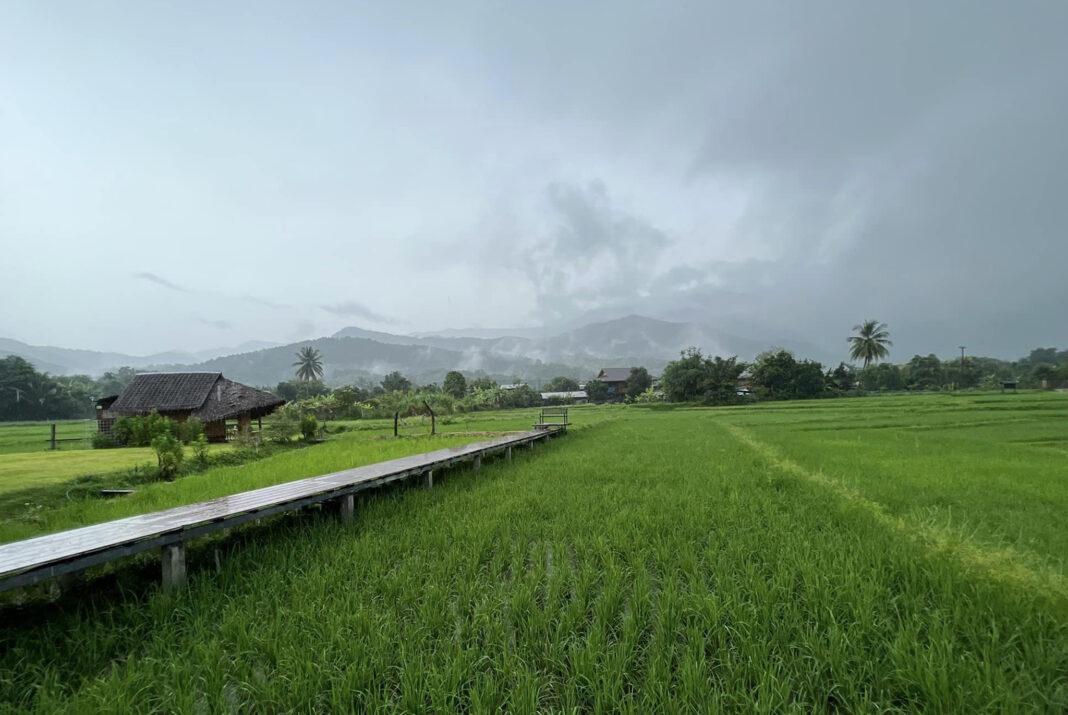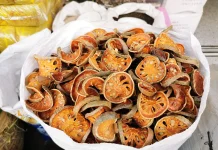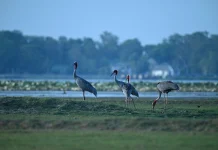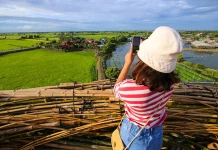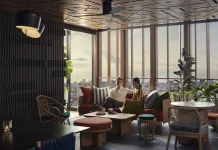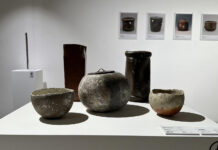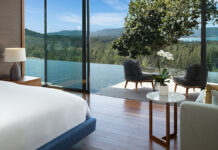Located between downtown Nan and the Thai–Lao border, Pua is a bucolic green valley dotted with local villages, small Buddhist temples, and majestic mountain ranges. This small town in a tranquil valley attracts visitors looking for a permaculture retreat, a family-run café, and a farm stay.
Historically speaking, Pua was a forefather of Nan province.
This small town, known as Woranakhon (Good City) in the mid-thirteenth century, found itself in the middle of two powerhouses – the Sukhothai and Chiang Mai kingdoms. Woranakhon, however, was able to gain the respect and fortune worthy of a larger kingdom, not least because it controlled salt supplies throughout the mountain ranges thanks to the ancient salt wells located 60 kilometers from Pua that are still active. A small town grew into a larger one as trade expanded and Woranakhon moved its capital to downtown Nan, leaving the former capital sleepily resting in the misty valley.

If you want to see the old city-state, go to the Wiang Woranakhon Old City Wall in Pua district where a small section of the city wall with the entrance gate was rebuilt on the historical site. Within walking distance from the city wall is the thirteenth-century Wat Phra That Beng Sakat, which is said to stand on the ancient city’s ground. The old temple has been renovated several times, but it is still worth seeing because of its distinctive Thai Lue architecture. Because the temple is on a hill, you can see the Pua Valley, which is a jumble of rice paddies and farmhouses that stretch all the way to the majestic Doi Phu Kha range.
More Bangkok Big Ears stories:
- Luang Phra Bang: Culture on a plate
- Mawlamyine: Mysteries in the mist.
- On top of the world
- Hue: a citadel of calm
Pua has long been the home of the Lue, a Tai-speaking ethnic group that is spread across southern China, Myanmar, Laos, Vietnam, and Thailand. Different groups of Lue arrived in Pua from various places and times, but they all contributed to the communities with their art and culture. Some of the best Lue architecture can be found in the temples of Wat Rong Ngae and Wat Ton Laeng. The traditional Lue temple is humble and small, with a strong sense of peace and calm, in contrast to the grandiose and imposing Siamese style in central Thailand.

The authentic beauty of Wat Ton Laeng, for example, draws visitors and culture buffs. The ordination hall was built in 1884 in the distinctive Lue style with three-tiered hipped roofs. Its gable is decorated with a colorful sunray motif, and decorative Naga finials mark the edge of the lower-hipped roofs. Two lion statues guard the main entrance leading into the ordination hall. The best time to visit Wat Ton Laeng is in the morning, when the sun filters light into the chapel hall, revealing the seated Buddha image beyond the walls of hanging flags.
Pua has become a popular destination for visitors looking for beautiful countryside minus the crowds found in Chiang Mai or Pai in Mae Hong Son.
Daidib Daidee farm stay, located in the middle of Ban Sila Laeng’s paddy fields, promotes permaculture and healthy living through simple yoga routines in the morning and home-cooked vegetarian meals made with local ingredients. Many hungry visitors, including Thai actor and model Ananda Everingham, are drawn to the farm for their pizza baked in a wood-fired clay oven. And lying down on a water buffalo is a once-in-a-lifetime experience.

If reconnecting with nature and a permaculture retreat with Daidib Daidee isn’t enough of a rural escape, the Farmer School Home Stay in Silaphet, 7 kilometers south of Sila Laeng, is an inspiring place for a digital detox. The Farmer School Home Stay checks all the boxes for a rural weekender: tasty local dishes, a lovely farmhouse with a bathtub and a view to die for, log fires, and a friendly host. Outside, you can enjoy the fresh air, help with farm chores for fun, or roam freely through the rice fields with a view of the surrounding hills.
Nothing says good morning like a good cup of coffee, and it’s impossible to avoid a cool coffee shop while traveling around Pua. Nan has recently become a destination for coffee enthusiasts, thanks to Nan-born American roaster Kaleb Jordan, who lives 60 kilometers north of Pua. Kaleb, also known as “K” among coffee connoisseurs, is introducing many coffee varieties to the remote hill-tribe villages of Nan and teaching coffee farmers how to process and roast the beans like pros.

An average visitor will go to Ban Tai Lue Café, which boasts an Instagram-worthy setting in the middle of picturesque rice fields. The café-cum-souvenir shop is run by a local textile vendor and features a number of rustic Lue farmhouses and rice barns decorated with famous Lue woven fabrics known as “Pha Lai Nam Lai.” They are connected by rustic bamboo walkways where everyone loves to take a selfie and quickly share it with their followers.
Coffee connoisseurs, on the other hand, should head to Nana Café (formerly “Gem Forrest”) for the best caffeine fix. Nana is probably not the coolest café for Instagram, but it serves the best cup of coffee grown in Nan. Some of the best varieties, including Java and Typica, as well as Geisha, the sought-after bean, can be found here.

Thailand’s countryside may have been declared endangered, but it has not yet vanished. If you know what to look for, you will have a rewarding experience. Bottom line: Pua is an inspiring place to leave your screen for a hundred shades of green. The best time to visit Pua is between September and February when the rice paddies transition from perfect green to warm golden fields. You’ll need a week or more to fully appreciate the charms of this small valley town.
IF YOU GO
Domestic flights operate daily between Bangkok and Nan. Pua is 60 kilometers north of downtown Nan. Visitors can rent a car from Nan airport for self-drive trips or arrange for a van with a driver.
NOTE: The article is published in Thai PBS World website on September 20, 2022.

